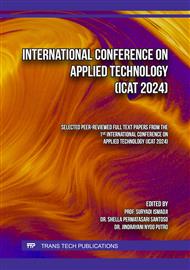[1]
B. Salah, "Real-time implementation of a fully automated industrial system based on ir 4.0 concept," Actuators, vol. 10, no. 12, 2021.
DOI: 10.3390/act10120318
Google Scholar
[2]
C. Edwards, "Real-time advanced analytics, automated production systems, and smart industrial value creation in sustainable manufacturing internet of things," Journal of Self-Governance and Management Economics, vol. 9, no. 2, 2021.
DOI: 10.22381/jsme9220213
Google Scholar
[3]
S.L. Pizzagalli, V. Kuts, and T. Otto, "Usercentred design in industrial collaborative automated systems," Proceedings of the Estonian Academy of Sciences, vol. 70, no. 4, 2021.
DOI: 10.3176/proc.2021.4.10
Google Scholar
[4]
H. A. Gabbar and M. Idrees, "ARSIP: Automated Robotic System for Industrial Painting," Technologies (Basel), vol. 12, no. 2, 2024.
DOI: 10.3390/technologies12020027
Google Scholar
[5]
Z. Lin et al., "Recent Advances in Perceptive Intelligence for Soft Robotics," 2023.
DOI: 10.1002/aisy.202200329
Google Scholar
[6]
A.F. Azocar and E. J. Rouse, "Characterization of Open-loop Impedance Control and Efficiency in Wearable Robots," IEEE Robot Autom Lett, vol. 7, no. 2, 2022.
DOI: 10.1109/LRA.2022.3150523
Google Scholar
[7]
A. Whitman, G. Clayton, A. Poultney, and H. Ashrafiuon, "Asymptotic Solution and Trajectory Planning for Open-Loop Control of Mobile Robots," Journal of Dynamic Systems, Measurement and Control, Transactions of the ASME, vol. 139, no. 5, 2017.
DOI: 10.1115/1.4035169
Google Scholar
[8]
J.M. Gandarias, Y. Wang, A. Stilli, A.J. Garcia-Cerezo, J.M. Gomez-De-Gabriel, and H.A. Wurdemann, "Open-loop position control in collaborative, modular variable-stiffness-link (VSL) robots," IEEE Robot Autom Lett, vol. 5, no. 2, 2020.
DOI: 10.1109/LRA.2020.2969943
Google Scholar
[9]
E.H.E. Suryadarma, P.W. Laksono, and I. Priadythama, "Optimal PLA+ 3D Printing Parameters through Charpy Impact Testing: A Response Surface Methodology," Jurnal Optimasi Sistem Industri, vol. 23, no. 1, p.76–91, 2024.
DOI: 10.25077/josi.v23.n1.p76-91.2024
Google Scholar
[10]
M. R. Hasan, I. J. Davies, A. Pramanik, M. John, and W. K. Biswas, "Potential of recycled PLA in 3D printing: A review," Sustainable Manufacturing and Service Economics, vol. 3, 2024.
DOI: 10.1016/j.smse.2024.100020
Google Scholar
[11]
J. R. Croxell, R. Mead, and J. B. Weinberg, "Designing robot competitions that promote AI solutions: Lessons learned competing and designing," in AAAI Spring Symposium - Technical Report, 2007.
Google Scholar
[12]
D. Zhang, J. Wang, L. Qian, and J. Yi, "Stepper motor open-loop control system modeling and control strategy optimization," Archives of Electrical Engineering, vol. 68, no. 1, 2019.
DOI: 10.24425/aee.2019.125980
Google Scholar
[13]
N. Mehrabi and J. McPhee, "Model-Based Control of Biomechatronic Systems," Handbook of Biomechatronics, p.95–126, Jan. 2019.
DOI: 10.1016/B978-0-12-812539-7.00004-0
Google Scholar
[14]
P. Ban, S. Desale, R. Barge, and P. Chavan, "Intelligent Robotic Arm," ITM Web of Conferences, vol. 32, 2020.
DOI: 10.1051/itmconf/20203201005
Google Scholar
[15]
P. Parikh, A. Sharma, R. Trivedi, D. Roy, and K. Joshi, "Performance evaluation of an indigenously-designed high performance dynamic feeding robotic structure using advanced additive manufacturing technology, machine learning and robot kinematics," International Journal on Interactive Design and Manufacturing, 2023.
DOI: 10.1007/s12008-023-01513-3
Google Scholar
[16]
T. Zhou, Q. Zhu, Y. Ye, and J. Du, "Humanlike Inverse Kinematics for Improved Spatial Awareness in Construction Robot Teleoperation: Design and Experiment," J Constr Eng Manag, vol. 149, no. 7, 2023.
DOI: 10.1061/jcemd4.coeng-13350
Google Scholar


